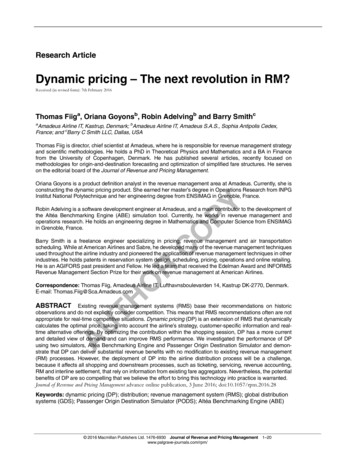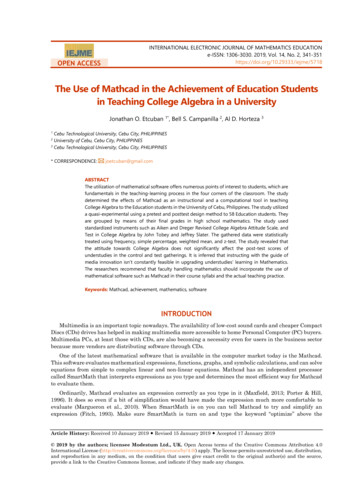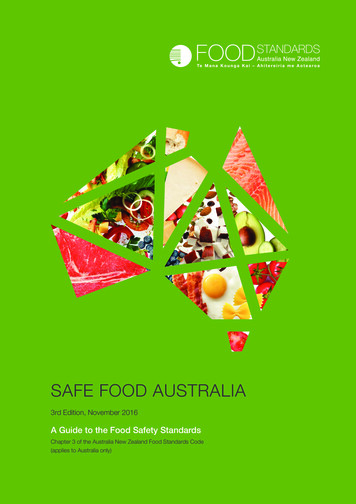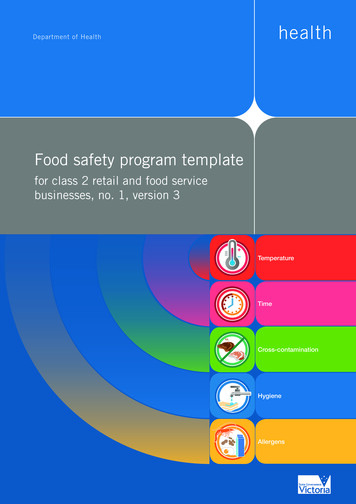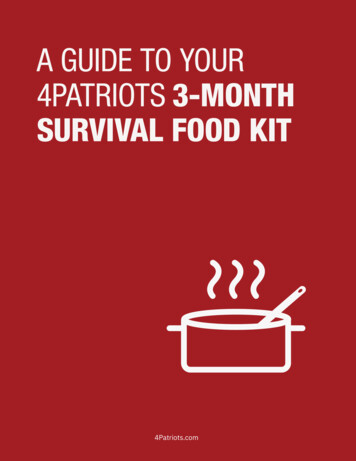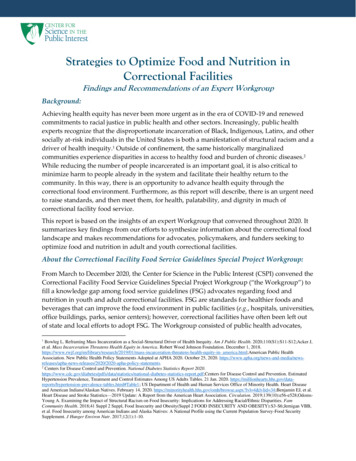
Transcription
Strategies to Optimize Food and Nutrition inCorrectional FacilitiesFindings and Recommendations of an Expert WorkgroupBackground:Achieving health equity has never been more urgent as in the era of COVID-19 and renewedcommitments to racial justice in public health and other sectors. Increasingly, public healthexperts recognize that the disproportionate incarceration of Black, Indigenous, Latinx, and othersocially at-risk individuals in the United States is both a manifestation of structural racism and adriver of health inequity.1 Outside of confinement, the same historically marginalizedcommunities experience disparities in access to healthy food and burden of chronic diseases.2While reducing the number of people incarcerated is an important goal, it is also critical tominimize harm to people already in the system and facilitate their healthy return to thecommunity. In this way, there is an opportunity to advance health equity through thecorrectional food environment. Furthermore, as this report will describe, there is an urgent needto raise standards, and then meet them, for health, palatability, and dignity in much ofcorrectional facility food service.This report is based on the insights of an expert Workgroup that convened throughout 2020. Itsummarizes key findings from our efforts to synthesize information about the correctional foodlandscape and makes recommendations for advocates, policymakers, and funders seeking tooptimize food and nutrition in adult and youth correctional facilities.About the Correctional Facility Food Service Guidelines Special Project Workgroup:From March to December 2020, the Center for Science in the Public Interest (CSPI) convened theCorrectional Facility Food Service Guidelines Special Project Workgroup (“the Workgroup”) tofill a knowledge gap among food service guidelines (FSG) advocates regarding food andnutrition in youth and adult correctional facilities. FSG are standards for healthier foods andbeverages that can improve the food environment in public facilities (e.g., hospitals, universities,office buildings, parks, senior centers); however, correctional facilities have often been left outof state and local efforts to adopt FSG. The Workgroup consisted of public health advocates,1Bowleg L. Reframing Mass Incarceration as a Social-Structural Driver of Health Inequity. Am J Public Health. 2020;110(S1):S11-S12;Acker J,et al. Mass Incarceration Threatens Health Equity in America. Robert Wood Johnson Foundation. December 1, /01/mass-incarceration-threatens-health-equity-in- america.html;American Public HealthAssociation. New Public Health Policy Statements Adopted at APHA 2020. October 25, 2020. .2Centers for Disease Control and Prevention. National Diabetes Statistics Report rs for Disease Control and Prevention. EstimatedHypertension Prevalence, Treatment and Control Estimates Among US Adults Tables. 21 Jan. 2020. sion-prevalence-tables.html#Table1; US Department of Health and Human Services Office of Minority Health. Heart Diseaseand American Indians/Alaskan Natives. February 14, 2020. https://minorityhealth.hhs.gov/omh/browse.aspx?lvl 4&lvlid 34;Benjamin EJ, et al.Heart Disease and Stroke Statistics—2019 Update: A Report from the American Heart Association. Circulation. 2019;139(10):e56-e528;OdomsYoung A. Examining the Impact of Structural Racism on Food Insecurity: Implications for Addressing Racial/Ethnic Disparities. FamCommunity Health. 2018;41 Suppl 2 Suppl, Food Insecurity and Obesity(Suppl 2 FOOD INSECURITY AND OBESITY):S3-S6;Jernigan VBB,et al. Food Insecurity among American Indians and Alaska Natives: A National Profile using the Current Population Survey-Food SecuritySupplement. J Hunger Environ Nutr. 2017;12(1):1-10.
2criminal justice reform advocates, researchers, and officials from public health and correctionalagencies at the federal, state, and local level. Additionally, a formerly incarcerated individualand a family member of an incarcerated person participated periodically.After agreeing on our objectives for gathering information and developing recommendations,the Workgroup met monthly via Zoom, with each meeting being devoted to one or more of thefollowing topics: demographic characteristics of the incarcerated population; key nutritionrelated health concerns for incarcerated people; operational characteristics of correctional foodservice; correctional facility food and nutrition policies and compliance; food-relatedexperiences of incarcerated people; and barriers, facilitators and best practices for improvingnutrition in correctional facilities. Prior to each meeting, members reviewed documents such aspolicies, research findings, and investigative reports that addressed the topic of interest. Duringthe meetings, presentations and facilitated discussions deepened our understanding of theissues. Following the information-gathering phase of the work, CSPI drafted a summary of theWorkgroup’s key findings and recommendations that was refined based on two rounds offeedback from members.Summary of the Key Findings:Black, Latinx, and Indigenous individuals are disproportionately incarcerated in the UnitedStates.The United States has the largest incarcerated population in the world, at more than 2.1 millionindividuals,3 with year-end 2019 data indicating that 1.4 million individuals are confined instate or federal prisons; the remainder are in local jails.4 Following a stable rate of incarcerationfor most of the 20th Century, the incarceration rate began to dramatically increase starting in1975,5 reaching an all-time high in 2008 (1,000 incarcerated per 100,000 adults).6 This trend (oftenreferred to as “mass incarceration”) has historically and continues to disproportionately burdenhistorically marginalized groups: While the general adult population in the United States is approximately 63.7 percentwhite, 12.6 percent Black, and 16.3 percent Latinx,7 these racial/ethnic groups constitute31 percent, 33 percent, and 23 percent of the prison population, respectively.8 The greatest racial disparities in imprisonment rates are between Black and white males:overall, the imprisonment rate of Black males is 5.7 times greater than that of Whitemales, and Black males aged 18 to 19 years are 12 times as likely to be imprisoned asWhite males of the same age.93Maruschak LM, Minton TD. Correctional Populations in the United States, 2017-2018. Bureau of Justice Statistics. August 27, 2020.https://www.bjs.gov/index.cfm?ty pbdetail&iid 70264Carson, EA. Prisoners in 2019. Department of Justice, Bureau of Justice Statistics. October 2020. https://www.bjs.gov/content/pub/pdf/p19.pdf5Langan PA, et al. Historical Statistics on Prisoners in State and Federal Institutions, Yearend 1925-86. Bureau of Justice Statistics. May 1098NCJRS.pdf; U.S. Bureau of the Census. Projections of the Population of the United States:1975 to 2050. Current Population Reports. 1975; P-25(601). publications/1975/demo/p25601.pdf.6Maruschak, 2020.7Racial/ethnic terminology taken from source material. Humes KR, Jones NA, Ramirez RR. Overview of Race and Hispanic Origin: 2010.United States Census Bureau. March 2011. -02.pdf.8Carson, 2020.9Carson, 2020.
3 Indigenous individuals are incarcerated at more than twice the rate of whiteAmericans.10In one survey, 16 percent of transgender adults reported having been incarcerated, and47 percent of Black transgender people reported having been incarcerated at some pointduring their lives.11The most recently available data (late 2018) estimate that approximately 37,500 youths weredetained (combined correctional and residential facilities),12 with the most recently availablestratified data (2017) showing that 28,000 youths were detained in juvenile correctional facilitiesand 4,500 in adult jails and prisons.13 When compared to white youth in 2017, Black,Indigenous, and Latinx youth were 4.6, 2.9, and 1.4 times more likely to be incarcerated,respectively.14Currently and formerly incarcerated people are more likely to have certain nutrition-relatedchronic diseases and risk factors compared to the general population.The same socially disadvantaged groups that are disproportionately incarcerated in the UnitedStates (i.e., Black, Latinx, and Indigenous individuals) are also more likely to develop nutritionrelated chronic health conditions, including diabetes, hypertension, and cardiovascular disease,as well as obesity, which increases the risk of developing the aforementioned conditions.15 Themedian time served by individuals released from state prisons in 2016 was 1.3 years, whichequates to more than 1400 meals eaten while incarcerated; as diet is a key modifier of severalpreventable diseases, the quality of food served in correctional facilities may have long-termhealth ramifications.16According to nationally representative data from 2011 to 2012, the prevalence of overweight(BMI 25) and obesity (BMI 30) among adults is similar in the incarcerated and non-10Daniel, R. Since You Asked: What Data Exists About Native American People in the Criminal Justice System? Prison Policy Initiative. April22, 2020. e/11Grant JM, et al. Injustice at Every Turn: A Report of the National Transgender Discrimination Survey. National Center for TransgenderEquality & National Gay and Lesbian Task Force. 2011:163. docs/resources/NTDS Report.pdf12Hockenberry S, Sladky A. Juvenile Justice Statistics: National Report Series Bulletin. U.S. Department of Justice. December selected-findings.pdf13The Prison Policy Initiative has classified the nine categories from the Census of Juveniles in Residential Placement into either correctionalfacilities (these are more restrictive, i.e., detention center, long-term secure facility, reception/diagnostic center) or residential facilities, in whichyouths can still participate in community life and which may offer tailored programs/services (i.e., residential treatment center, group home,ranch/wilderness camp, shelter, boot camp, etc.). Sawyer W. Youth Confinement: The Whole Pie 2019. Prison Policy Initiative. December 19,2019. l14The W. Haywood Burns Institute. United States of Disparities. 2021.https://usdata.burnsinstitute.org/#comparison 2&placement 1&races 2,3,4,5,6&offenses 5,2,8,1,9,11,10&year 2017&view map15Centers for Disease Control and Prevention, National Center for Health Statistics. Prevalence of Obesity and Severe Obesity Among Adults:United States, 2017-2018. Data Brief No. 360. February db360.htm#: :text %201);U.S. Departments of Health and Human Services Office of Minority Health. Obesity andAmerican Indians/Alaska Natives. March 26, 2020. https://minorityhealth.hhs.gov/omh/browse.aspx?lvl 4&lvlid 40;Centers for Disease Controland Prevention. National Diabetes Statistics Report 2020. national-diabetes-statisticsreport.pdf;Centers for Disease Control and Prevention. Estimated Hypertension Prevalence, Treatment and Control Estimates Among US AdultsTables. January 21, 2020. nsion-prevalence-tables.html#Table1; US Department of Health andHuman Services Office of Minority Health. Heart Disease and American Indians/Alaskan Natives. February 14, x?lvl 4&lvlid 34 ;Benjamin EJ, et al. Heart Disease and Stroke Statistics—2019 Update: A Report from the American Heart Association. Circulation.2019;139(10):e56-e528.16Kaeble D. Time Served in State Prison, 2016. U.S. Department of Justice, Bureau of Justice Statistics. November f
4institutionalized populations.17 However, while there is some inconsistency in the literature,several studies reported an association between incarceration and weight gain, with a 2020systematic review and meta-regression reporting that weight increased steeply at the beginningof incarceration and appeared to level off after two years. The mean weight gain was 11.7 lbs. at2 years, which is up to five times the rate in the middle-aged US population.18From 2011 to 2012, 44 percent of people in prison custody and 45 percent of people in jailsreported ever having a chronic medical condition, compared to just 31 percent and 27 percent oftheir non-incarcerated counterparts, respectively.19 Incarcerated individuals in prisons and jailsare respectively 1.5 and 2 times more likely to have high blood pressure, diabetes, or asthmacompared to a standardized general population.20Increased risk of chronic disease may persist after individuals are released from correctionalfacilities. A prospective study found that formerly incarcerated individuals experienced 60percent higher odds of developing hypertension in young adulthood compared to those whohad never been incarcerated when adjusting for smoking, alcohol and illicit drug use, andfamily income.21 A prospective study of veterans showed that incarceration within the last yearwas associated with uncontrolled hypertension compared to those who had never beenincarcerated, after adjusting for confounding factors.22Formerly incarcerated individuals face several social and economic barriers to meeting basicneeds.23 Specifically, there is an association between history of incarceration and increased riskof food insecurity, the latter of which is linked to a range of negative health outcomes.24Correctional food service operations vary widely across and within federal, state, and localjurisdictions.The Workgroup’s experiences indicated that there is no one uniform approach to food service incorrections; federal, state, and local governments usually set their own policies and proceduresfor the facilities in their jurisdiction, often with different agencies overseeing adult and youthdetention.Some of the more variable characteristics of correctional food service have significantimplications for making improvements. For example, some correctional agencies outsource foodservice for some or all facilities to companies like Aramark and Trinity, while others use selfoperated food service. Additionally, in some jurisdictions each facility does its own food17Centers for Disease Control and Prevention. Obesity and Overweight. National Center for Health Statistics. January 11, weight.htm; Maruschak LM, Berzofsky M, Unangst J. Medical Problems of State and FederalPrisoners and Jail Inmates, 2011-12 (NCJ 248491). Bureau of Justice Statistics. 2015. f.18Bondolfi C, et al. Impact of Incarceration on Cardiovascular Disease Risk Factors: A Systematic Review and Meta-Regression on Weight andBMI Change. BMJ Open. 2020;10(10):e039278.19Maruschak, 2015.20Maruschak, 2015.21Wang EA, et al. Incarceration, Incident Hypertension, and Access to Health Care: Findings From the Coronary Artery Risk Development inYoung Adults (CARDIA) Study. Arch Intern Med. 2009;169(7):687–693.22Howell BA, et al. Incarceration History and Uncontrolled Blood Pressure in a Multi-Site Cohort. J Gen Intern Med. 2016;31(12):1496-1502.23Harding DJ, et al. Making Ends Meet After Prison. J Policy Anal Manage. 2014;33(2):440-470;Western B, et al. Stress and Hardship afterPrison. AJS. 2015;120(5):1512-47.24Testa A, Jackson DB. Food Insecurity Among Formerly Incarcerated Individuals. Crim Justice Behav. 2019; 46(10): 1493-1511.
5production, but other jurisdictions centralize food production and distribute ready-to-eat mealsto each correctional facility, which influences the types and quality of foods that are served.Despite this variation in policy and practice, the Workgroup found several consistentcharacteristics across jurisdictions. Typically, correctional agency officials above the facilitylevel prescribe and oversee planning of standardized menus and at least some procurement andcontracting activities. Limited budget also appears to be a consistent feature: among adultcorrectional facilities, the food budget per person per day (including all food costs andsometimes additional costs of labor and utensils) typically ranges from 1- 4.50.25 Food serviceis typically a very small percentage of the agency’s total budget and in many states, the foodexpenditures per person have decreased markedly over the past 20 years.26There is substantial variation in the robustness of food and nutrition policies for correctionalsettings, as well as inconsistent accountability to put policy into practice.Ideally, all correctional food service operations would provide balanced, nutritious, safe,appealing, culturally relevant meals that promote health, well-being, and dignity forincarcerated people. The Workgroup’s experiences indicated that reality often deviates fromthis ideal due to complex factors along the continuum from policy to practice.Among Adult Facilities:Federal, state, and local jurisdictions vary in specificity and strength of their written food andnutrition guidelines, which are typically part of the internal policy of the correctional agency. Ifnutrition standards are included, they are often nutrient adequacy goals (i.e., the DietaryReference Intakes), since these are mandated by the American Correctional Association (ACA),which accredits most facilities.27 Nutrient adequacy goals are necessary to prevent deficienciesbut are not sufficient to ensure that the meals provided are generally consistent with the DietaryGuidelines for Americans (DGA), which provide food-based recommendations that considerhealth promotion and chronic disease prevention in addition to nutrient adequacy.Written policy guides menu planning in correctional agencies; however, lack of specificityallows for inconsistent interpretation at the facility level and diminishes the policy’s value inholding facilities accountable. Enforcement mechanisms vary across facilities: periodic audits,which may be announced or unannounced, may be conducted by the correctional agency, thejurisdiction’s health department, the ACA, or a combination. When violations are identified, thefacility might need to submit a correction plan to the government auditor or ACA, though thelatter has no legal power to enforce its standards. Incarcerated individuals can also submit agrievance through internal agency mechanisms or (depending on the nature of the complaint)sue under the Eighth Amendment, which prohibits governments from imposing cruel andunusual punishment. In practice, it is very difficult to resolve complaints in these manners.25Soble L, Stroud K, Weinstein M. Eating Behind the Bars: Ending the Hidden Punishment of Food in Prison. Impact Justice. IJ-Eating-Behind-Bars.pdf26For example, Impact Justice calculated that only 4 percent of the Texas Department of Correction’s FY 2019 operating budget was allocated tofood services. Soble, 2020.27Morgan R. Developing Prison Standards Compared. July 1, 2000; 2(3):325-342; American Correctional Association. Seeking Accreditation. August 15,2008. iles/library/overviewoftheprocess 0.pdf
6Among Youth Facilities:Many juvenile detention facilities participate in the National School Lunch Program (NSLP) andSchool Breakfast Program (SBP). In these programs, federal reimbursement for meals iscontingent on compliance with U.S. Department of Agriculture (USDA) meal pattern guidelinesbased on the 2010 DGA and adherence to “Smart Snacks” standards for other foods availableduring the weekday.28The Workgroup identified several opportunities for improvement concerning the mealstandards for facilities participating in the NSLP and SBP, including implementation of anadded sugar limit and improving palatability of meals by requiring some amount of fruit andvegetable servings to be fresh. Participating facilities are not subject to the USDA nutritionstandards for the dinner meal or for snacks and beverages sold and served outside of schoolhours, which leaves a gap in policy that may result in lower expectations for healthfulness.In Workgroup member investigations of food conditions in state prisons, incarceratedindividuals consistently reported low-quality and unappetizing food, limited access to freshfruits and vegetables, rushed and hostile eating environments, and staff neglect of food safetyand quality control measures.The Workgroup reviewed findings from Impact Justice and the Farm to Prison Project, based onsurveys and focus groups with approximately 300 individuals who were formerly or currentlyincarcerated in state prisons. Additionally, one formerly incarcerated individual generouslyshared her experiences with us in a question-and-answer session. Consistent across reportswere assertions of low-quality meals that looked, smelled, and tasted unappetizing, or wereserved at an inappropriate temperature; reports of rare or no access to fresh produce; consistentfeelings of physical hunger; rushed and hostile eating environments that perpetuatedsentiments of dehumanization related to food; and lack of oversight of facility staff permittingneglect of policies and procedures at the expense of food quality and safety.29Limited resources, security concerns, and lack of political will are consistent barriers toimproving food quality and nutrition in correctional facilities. Progress requires patience, buyin from leadership, and robust accountability measures.The Workgroup heard accounts from members who have been involved in efforts to adopt FSGpolicies or other strategies to improve the food environment in correctional facilities. Theseinclude individuals representing the jurisdictions and organizations of New York City,Philadelphia, Multnomah County, OR, Washington, Oregon, Maryland (via the Farm to PrisonProject), Alliance for a Healthier Generation, and the Federal Bureau of Prisons. These membersshared the details of each intervention including policies and standards, facilitators of andbarriers to progress, and any best practices identified.Factors that facilitated FSG implementation include: Incorporation of standards into policies and contracts to allow for accountability;28However, the USDA has not published the exact number of juvenile detention facilities that participate; rather, they are included in the broadercount of residential childcare institutions.29Soble, 2020.
7 Buy-in from all levels of administration;Input from incarcerated individuals to evaluate acceptability of food;Patience for incremental change; andMonitoring and evaluation to hold facilities accountable and to track outcomes.Common barriers to progress include: Insufficient funds to incorporate fresh produce and cook from scratch; Insufficient compensation to attract and minimize turnover of skilled food service staff; Limited capacity of existing food production systems and equipment to make menuchanges; Security concerns (e.g., that fresh fruit can be fermented to alcohol); Meal timing restrictions, which limit the number of menu choices (e.g., salad bars); and Cultural stigmatization of incarcerated people, leading to lack of political support forchange.Recommendations for Optimizing Food and Nutrition in Correctional Facilities:While it is impossible to make universally applicable generalizations in such a heterogeneoussystem, the Workgroup’s discussions tended to reveal that there is an urgent need to raisestandards (and then meet them) for health, palatability, and dignity in correctional facility foodservice overall, particularly when centering the perspective of people who have beenincarcerated. The Workgroup’s recommendations below are not exhaustive, but serve toprovide a minimum set of benchmarks for policymakers, advocates, and funders to pursueimmediately.Policy Recommendations:We recommend that all governments with authority over correctional facilities adopt or amendtheir written policies, such as legislation, executive order, administrative policy, and allapplicable contracts, to include: FSG concerning nutrition for all foods and beverages served and sold in the facility thatmeet or exceed the most recent Dietary Guidelines for Americans.o Selected FSG should be met through minimally processed foods and beveragesand preclude the need to provide essential nutrients through a fortified beverage. Food safety standards that are at least as strong as those included in the Food ServiceGuidelines for Federal Facilities and, if needed, a timeline for phasing them in. Requirement that potable, palatable drinking water be accessible to incarceratedindividuals at mealtimes and as much as possible throughout the rest of the day.o Appropriate agencies should assure that drinking water access points (fountains,sinks, etc.) are maintained and that water at the tap is tested annually forcompliance with both the National Primary Drinking Water Regulations andNational Secondary Drinking Water Regulations, or state limits if morestringent.30 Results should be posted near water access points.30The U.S. Environmental Protection Agency establishes both National Primary Drinking Water Regulations, which are legally enforceable andlimit the levels of unsafe contaminants in drinking water, and National Secondary Drinking Water Regulations, which set non-mandatory limitsfor contaminants that negatively affect taste, color, and odor.
8 Measures that uphold the humanity and dignity of incarcerated people in relation tofood provision, including but not limited to:o Requirement that all facility staff who are involved in food service or overseedining should be trained on the importance to an individual’s physical andmental wellbeing of healthy food and a dignified eating experience.o Requirement that the incarcerated population be consulted about the menu,commissary selection, and other aspects of the food environment on an ongoingbasis and that their feedback be used to guide changes. This can be done withperiodic surveys and focus groups, perpetual mechanisms for submitting writtenfeedback, taste tests of new items under consideration, and other methods.o Requirement that each incarcerated individual be given at least 20 minutes ofseated time to consume each meal, not counting time spent waiting to beserved.31o Prohibiting all food-related punishments.o Requirement that the same selection of food and beverages be available toemployees and people in custody.Resource Allocation:Correctional facilities need more resources or reallocation of existing resources to provideconsistently safe, healthful, and appealing food service. Limited budgets for food and laborappear to be consistent barriers to improving food conditions throughout the system. The federal school meal program reimbursement rates of approximately 2 to 3.50 permeal provide a starting point for rethinking the correctional food budget, consideringthat costs will be greater to feed adults than youth.32 Investments in updates to kitchens, dining facilities, equipment, and storage may beneeded to make menu changes desired to meet higher standards for health, quality, anddignity. Compensation for food service workers should reflect the need to attract and retainskilled personnel. Governments, especially at the state level, are well-positioned to incentivize farm-toinstitution sourcing of fresh produce and other healthy foods to co-benefit localeconomies and food quality.Practice Recommendations:The following are additional strategies we recommend for correctional agencies and facilities toachieve a healthy, appetizing, and dignified eating experience for incarcerated people: Secure appropriate resources and equipment to maximize the use of fresh foods andcooking from scratch.31This the same amount of time advocates recommend for school meals.Federal Register. National School Lunch, Special Milk, and School Breakfast Programs, National Average Payments/MaximumReimbursement Rates. July 19, 2018. ntsmaximum32
9 Minimize the time between food preparation and service to maximize control oftemperature and quality. Recipe development should incorporate taste testing after thedish has been held, transported, reheated, etc. as it would be in practice.Incorporate choice of multiple options at each meal to the extent possible to upholdautonomy for incarcerated individuals.Offer a variety of healthy items at affordable prices in the commissary.Identify and implement needed improvements in the physical space and facility cultureto make the eating environment hospitable.Consider developing nutrition education, gardening, and culinary programming tosupport health and rehabilitation.
10AcknowledgementsThis report was funded by a grant from Voices for Healthy Kids, an initiative of the AmericanHeart Association (AHA). The AHA has not reviewed the data or science in this report. We aregrateful for the support from NaDa Shoemaker, Christine Compton, and the rest of the Voicesteam over the course of the project.Jessi Silverman, Policy Associate, and Madeline Holt, Intern, of the Center for Science in thePub
optimize food and nutrition in adult and youth correctional facilities. About the Correctional Facility Food Service Guidelines Special Project Workgroup: From March to December 2020, the Center for Science in the Public Interest (CSPI) convened the Correctional Facility Food Service Guidelines Special Project Workgroup ("the Workgroup") to
